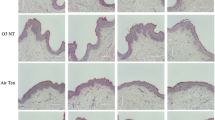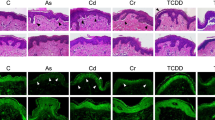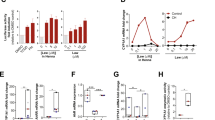Abstract
Being exposed to ground-level ozone (O3), as it is often the case in polluted cities, is known to have a detrimental impact on skin. O3 induces antioxidant depletion and lipid peroxidation in the upper skin layers and this effect has repercussions on deeper cellular layers, triggering a cascade of cellular stress and inflammatory responses. Repetitive exposure to high levels of O3 may lead to chronic damages of the cutaneous tissue, cause premature skin aging and aggravate skin diseases such as contact dermatitis and urticaria. This review paper debates about the most relevant experimental approaches that must be considered to gather deeper insights about the complex biological processes that are activated when the skin is exposed to O3. Having a better understanding of O3 effects on skin barrier properties and stress responses could help the whole dermato-cosmetic industry to design innovative protective solutions and develop specific cosmetic regime to protect the skin of every citizen, especially those living in areas where exposure to high levels of O3 is of concern to human health.
This is a preview of subscription content, access via your institution
Access options
Subscribe to this journal
Receive 6 print issues and online access
$259.00 per year
only $43.17 per issue
Buy this article
- Purchase on Springer Link
- Instant access to full article PDF
Prices may be subject to local taxes which are calculated during checkout


Similar content being viewed by others
References
Bouwstra JA, Ponec M. The skin barrier in healthy and diseased state. Biochim Biophys Acta. 2006;1758:2080–95.
Kolarsick PAJ, Kolarsick MA, Goodwin C. Anatomy and Physiology of the Skin. J Dermatol Nurses Assoc. 2011;3:203–13.
Steven AC, Steinert PM. Protein composition of cornified cell envelopes of epidermal keratinocytes. J Cell Sci. 1994;700:693–700.
Pouillot A, Dayan N, Polla AS, Polla LL, Polla BS. The stratum corneum: a double paradox. J Cosmet Dermatol. 2008;7:143–8.
McDaniel D, Farris P, Valacchi G. Atmospheric skin aging-Contributors and inhibitors. J Cosmet Dermatol. 2018;17:124–37.
Thiele JJ, Traber MG, Polefka TG, Cross CE, Packer L. Ozone-Exposure Depletes Vitamin E and Induces Lipid Peroxidation in Murine Stratum Corneum. J Investig Dermatol. 1997;108:753–7.
Fuks KB, Woodby B, Valacchi G. Skin damage by tropospheric ozone. Der Hautarzt. 2019;70:163–8.
Valacchi G, Fortino V, Bocci V. The dual action of ozone on the skin. Br J Dermatol. 2005;153:1096–100.
Mustafa MG. Biochemical basis of ozone toxicity. Free Radic Biol Med. 1990;9:245–65.
EEA. Air quality 2018 - EEA report 12 2018. 2018 https://doi.org/10.2800/777411.
Boleti E, Hueglin C, Takahama S. Trends of surface maximum ozone concentrations in Switzerland based on meteorological adjustment for the period 1990–2014. Atmos Environ. 2019;213:326–36.
Feng Z, Hu E, Wang X, Jiang L, Liu X. Ground-level O3 pollution and its impacts on food crops in China: a review. Environ Pollut. 2015;199:42–8.
Bocci V. Physical-chemical properties of ozone – natural production of ozone: the toxicology of ozone. In: Springer Science & Business Media, editors. OZONE A new medical drug. Dordrecht: Springer Netherlands; 2010. p. 1–4.
Cross CE, Valacchi G, Schock B, Wilson M, Weber S, Eiserich J et al. Environmental oxidant pollutant effects on biologic systems: a focus on micronutrient antioxidant-oxidant interactions. Am J Respir Crit Care Med. 2002;166. https://doi.org/10.1164/rccm.2206015.
European Environmental Agency. European Environmental Agency. (2019). Air quality in Europe — 2019 report — EEA Report No 10/2019 (Issue 10). Air quality in Europe — 2019 report — EEA Report No 10/2019. 2019 https://doi.org/10.2800/822355.
Tang G, Li X, Wang Y, Xin J, Ren X. Surface ozone trend details and interpretations in Beijing, 2001–2006. Atmos Chem Phys. 2009;9:8813–23.
Han S, Zhang M, Zhao C, Lu X, Ran L, Han M, et al. Differences in ozone photochemical characteristics between the megacity Tianjin and its rural surroundings. Atmos Environ. 2013;79:209–16.
Sticozzi C, Valacchi G. Effect of Ozone on Cutaneous Tissues. In: SpringerReference. Berlin/Heidelberg: Springer-Verlag; 2011. p. 918–22.
Simone Reuter BBA. Oxidative stress, inflammation, and cancer: how are they linked? Free Radic Biol Med. 2011;49:1603–16.
Bickers DR, Athar M. Oxidative stress in the pathogenesis of skin disease. J Investig Dermatol. 2006;126:2565–75.
Kammeyer A, Luiten RM. Oxidation events and skin aging. Ageing Res Rev. 2015;21:16–29.
Venza M, Visalli M, Beninati C, De Gaetano GV, Teti D, Venza I. Cellular Mechanisms of Oxidative Stress and Action in Melanoma. Oxid Med Cell Longev. 2015;2015:1–11.
Zhou Q, Mrowietz U, Rostami-Yazdi M. Oxidative stress in the pathogenesis of psoriasis. Free Radic Biol Med. 2009;47:891–905.
Ji H, Li X-K. Oxidative Stress in Atopic Dermatitis. Oxid Med Cell Longev. 2016;2016:1–8.
Fuks KB, Hüls A, Sugiri D, Altug H, Vierkötter A, Abramson MJ, et al. Tropospheric ozone and skin aging: results from two German cohort studies. Environ Int. 2019;124:139–44.
Xu F, Yan S, Wu M, Li F, Xu X, Song W, et al. Ambient ozone pollution as a risk factor for skin disorders. Br J Dermatol. 2011;165:224–5.
Pryor WA, Squadrito GL, Friedman M. A new mechanism for the toxicity of ozone. Toxicol Lett. 1995;82–83:287–93.
Valacchi G, Sticozzi C, Pecorelli A, Cervellati F, Cervellati C, Maioli E. Cutaneous responses to environmental stressors. Ann N Y Acad Sci. 2012;1271:75–81.
Pryor WA, Squadrito GL, Friedman M. The cascade mechanism to explain ozone toxicity: the role of lipid ozonation products. Free Radic Biol Med. 1995;19:935–41.
Lodovici M, Bigagli E. Oxidative stress and air pollution exposure. J Toxicol. 2011; 2011. https://doi.org/10.1155/2011/487074.
Valacchi G, Weber SU, Luu C, Cross CE, Packer L. Ozone potentiates vitamin E depletion by ultraviolet radiation in the murine stratum corneum. FEBS Lett. 2000;466:165–8.
Thiele JJ, Traber MG, Tsang K, Cross CE, Packer L. In vivo exposure to ozone depletes vitamins C and E and induces lipid peroxidation in epidermal layers of murine skin. Free Radic Biol Med. 1997;23:385–91.
Afaq F, Zaid MA, Pelle E, Khan N, Syed DN, Matsui MS, et al. Aryl hydrocarbon receptor is an ozone sensor in human skin. J Investig Dermatol. 2009;129:2396–403.
Mathes SH, Ruffner H, Graf-Hausner U. The use of skin models in drug development. Adv Drug Deliv Rev. 2014;69–70:81–102.
Dellambra E. Non-animal models in dermatological research. ALTEX. 2018;36:177–202.
Groeber F, Holeiter M, Hampel M, Hinderer S, Schenke-Layland K. Skin tissue engineering - In vivo and in vitro applications. Adv Drug Deliv Rev. 2011;63:352–66.
Poumay Y, Coquette A. Modelling the human epidermis in vitro: tools for basic and applied research. Arch Dermatol Res. 2007;298:361–9.
Kandárová H, Liebsch M, Schmidt E, Genschow E, Traue D, Spielmann H, et al. Assessment of the Skin Irritation Potential of Chemicals by Using the SkinEthic Reconstructed Human Epidermal Model and the Common Skin Irritation Protocol Evaluated in the ECVAM Skin Irritation Validation Study. Alter Lab Anim. 2006;34:393–406.
Kandárová H, Liebsch M, Gerner I, Schmidt E, Genschow E, Traue D, et al. The EpiDerm Test Protocol for the Upcoming ECVAM Validation Study on In Vitro Skin Irritation Tests — An Assessment of the Performance of the Optimised Test. Alter Lab Anim. 2005;33:351–67.
Alépée N, Grandidier MH, Cotovio J. Sub-categorisation of skin corrosive chemicals by the EpiSkinTM reconstructed human epidermis skin corrosion test method according to UN GHS: Revision of OECD Test Guideline 431. Toxicol Vitr. 2014;28:131–45.
El Ghalbzouri A, Siamari R, Willemze R, Ponec M. Leiden reconstructed human epidermal model as a tool for the evaluation of the skin corrosion and irritation potential according to the ECVAM guidelines. Toxicol Vitr. 2008;22:1311–20.
Netzlaff F, Lehr CM, Wertz PW, Schaefer UF. The human epidermis models EpiSkin®, SkinEthic® and EpiDerm®: An evaluation of morphology and their suitability for testing phototoxicity, irritancy, corrosivity, and substance transport. Eur J Pharm Biopharm 2005;60:167–78.
Thiele JJ, Traber MG, Podda M, Tsang K, Cross CE, Packer L. Ozone depletes tocopherols and tocotrienols topically applied to murine skin. FEBS Lett. 1997;401:167–70.
Weber SU, Thiele JJ, Cross CE, Packer L. Vitamin C, uric acid, and glutathione gradients in murine stratum corneum and their susceptibility to ozone exposure. J Investig Dermatol. 1999;113:1128–32.
Weber SU, Jothi S, Thiele JJ. [48] High-pressure liquid chromatography analysis of ozone-induced depletion of hydrophilic and lipophilic antioxidants in murine skin. Methods Enzymol. 2000;319:536–46.
Valacchi G, van der Vliet A, Schock B, Okamoto T, Obermuller-Jevic U, Cross C, et al. Ozone exposure activates oxidative stress responses in murine skin. Toxicology. 2002;179:163–70.
Valacchi G, Pagnin E, Corbacho AM, Olano E, Davis PA, Packer L, et al. In vivo ozone exposure induces antioxidant/stress-related responses in murine lung and skin. Free Radic Biol Med. 2004;36:673–81.
Numata I, Okuyama R, Memezawa A, Ito Y, Takeda K, Furuyama K, et al. Functional expression of heme oxygenase-1 in human differentiated epidermis and its regulation by cytokines. J Investig Dermatol. 2009;129:2594–603.
Tripp CS, Blomme EAG, Chinn KS, Hardy MM, LaCelle P, Pentland AP. Epidermal COX-2 Induction Following Ultraviolet Irradiation: suggested Mechanism for the Role of COX-2 Inhibition in Photoprotection. J Investig Dermatol. 2003;121:853–61.
Valacchi G, Pagnin E, Okamoto T, Corbacho AM, Olano E, Davis PA, et al. Induction of stress proteins and MMP-9 by 0.8 ppm of ozone in murine skin. Biochem Biophys Res Commun. 2003;305:741–6.
Lim Y, Phung AD, Corbacho AM, Aung HH, Maioli E, Reznick AZ, et al. Modulation of cutaneous wound healing by ozone: differences between young and aged mice. Toxicol Lett. 2006;160:127–34.
Sticozzi C, Pecorelli A, Lim A, Maioli E, Pagnin E, Davis PA, et al. Modulation of skin oxidative stress and inflammatory markers by environmental stressors. Differences between young and old. J Dermatol Sci. 2012;65:226–8.
Liu T, Zhang L, Joo D, Sun S-C. NF-κB signaling in inflammation. Signal Transduct Target Ther. 2017;2:17023.
Kaur S, Oddos T, Tucker-Samaras S. Regulation of DNA Repair Process by the Pro-Inflammatory NF-κB Pathway. In: New Research Directions in DNA Repair, InTech, 2013, p. 213–27.
Jung EC, Maibach HI. Animal Models for Percutaneous Absorption. In: Topical Drug Bioavailability, Bioequivalence, and Penetration. 2014. https://doi.org/10.1007/978-1-4939-1289-6.
He QC, Tavakkol A, Wietecha K, Begum-Gafur R, Ansari SA, Polefka T. Effects of environmentally realistic levels of ozone on stratum corneum function. Int J Cosmet Sci. 2006;28:349–57.
Mancebo SE, Wang SQ. Recognizing the impact of ambient air pollution on skin health. J Eur Acad Dermatol Venereol. 2015;29:2326–32.
Valacchi G, Pecorelli A, Belmonte G, Pambianchi E, Cervellati F, Lynch S, et al. Protective Effects of Topical Vitamin C Compound Mixtures against Ozone-Induced Damage in Human Skin. J Investig Dermatol. 2017;137:1373–5.
Curpen S, Francois-Newton V, Moga A, Hosenally M, Petkar G, Soobramaney V, et al. A novel method for evaluating the effect of pollution on the human skin under controlled conditions. Ski Res Technol. 2020;26:50–60.
Guo H, Callaway JB, Ting JP-Y. Inflammasomes: mechanism of action, role in disease, and therapeutics. Nat Med. 2015;21:677–87.
Zhong FL, Mamaï O, Sborgi L, Boussofara L, Hopkins R, Robinson K, et al. Germline NLRP1 Mutations Cause Skin Inflammatory and Cancer Susceptibility Syndromes via Inflammasome Activation. Cell. 2016;167:187–202.e17.
Sá DC, de, Festa, Neto C. Inflammasomes and dermatology. Bras Dermatol. 2016;91:566–78.
Beer HD, Contassot E, French LE. The inflammasomes in autoinflammatory diseases with skin involvement. J Investig Dermatol. 2014;134:1805–10.
Ferrara F, Pambianchi E, Pecorelli A, Woodby B, Messano N, Therrien JP, et al. Redox regulation of cutaneous inflammasome by ozone exposure. Free Radic Biol Med. 2020;152:561–70.
Kousha T, Valacchi G. The Air Quality Health Index and Emergency Department Visits for Urticaria in Windsor, Canada. J Toxicol Environ Heal Part A. 2015;78:524–33.
Valacchi G, Sticozzi C, Belmonte G, Cervellati F, Demaude J, Chen N, et al. Vitamin C compound mixtures prevent ozone-induced oxidative damage in human keratinocytes as initial assessment of pollution protection. PLoS ONE. 2015;10:1–15.
McCarthy JT, Pelle E, Dong K, Brahmbhatt K, Yarosh D, Pernodet N. Effects of ozone in normal human epidermal keratinocytes. Exp Dermatol. 2013;22:360–1.
Cotovio J, Onno L, Justine P, Lamure S, Catroux P. Generation of oxidative stress in human cutaneous models following in vitro ozone exposure. Toxicol Vitr. 2001;15:357–62.
Muresan XM, Narzt M-S, Woodby B, Ferrara F, Gruber F, Valacchi G. Involvement of cutaneous SR-B1 in skin lipid homeostasis. Arch Biochem Biophys. 2019;666:1–7.
Muresan XM, Sticozzi C, Belmonte G, Savelli V, Evelson P, Valacchi G. Modulation of cutaneous scavenger receptor B1 levels by exogenous stressors impairs “in vitro” wound closure. Mech Ageing Dev. 2018;172:78–85.
Weber SU, Tavakko A, Nabi, Z., Jothi S, Polefka TG, Packer L. The effects of tropospheric ozone on a human epidermal skin model (Epiderm). J Investig Dermatol. 1999;119:576.
Valacchi G, Muresan XM, Sticozzi C, Belmonte G, Pecorelli A, Cervellati F, et al. Ozone-induced damage in 3D-Skin Model is prevented by topical vitamin C and vitamin E compound mixtures application. J Dermatol Sci. 2016;82:209–12.
Klicks J, von Molitor E, Ertongur-Fauth T, Rudolf R, Hafner M. In vitro skin three-dimensional models and their applications. J Cell Biotechnol. 2017;3:21–39.
Rademacher F, Simanski M, Gläser R, Harder J. Skin microbiota and human 3D skin models. Exp Dermatol. 2018;27:489–94.
Valacchi G, Porada E, Rowe B. Ambient ozone and bacterium Streptococcus: a link between cellulitis and pharyngitis. Int J Occup Med Environ Health. 2015;28:771–4.
Skobowiat C, Postlethwaite AE, Slominski AT. Skin Exposure to Ultraviolet B Rapidly Activates Systemic Neuroendocrine and Immunosuppressive Responses. Photochem Photobio. 2017;93:1008–15.
Chen J, Roop DR. Genetically engineered mouse models for skin research: taking the next step. J Dermatol Sci. 2008;52:1–12.
Schneider MR. Genetic mouse models for skin research: strategies and resources. Genesis. 2012;50:652–64.
Michaudel C, Bataille F, Maillet I, Fauconnier L, Colas C, Sokol H et al. Ozone-Induced Aryl Hydrocarbon Receptor Activation Controls Lung Inflammation via Interleukin-22 Modulation. Front Immunol. 2020; 11. https://doi.org/10.3389/fimmu.2020.00144.
Abd E, Yousef SA, Pastore MN, Telaprolu K, Mohammed YH, Namjoshi S, et al. Skin models for the testing of transdermal drugs. Clin Pharm. 2016;8:163–76.
Godin B, Touitou E. Transdermal skin delivery: predictions for humans from in vivo, ex vivo and animal models. Adv Drug Deliv Rev. 2007;59:1152–61.
Baxter LK, Dionisio KL, Burke J, Ebelt Sarnat S, Sarnat JA, Hodas N, et al. Exposure prediction approaches used in air pollution epidemiology studies: Key findings and future recommendations. J Expo Sci Environ Epidemiol. 2013;23:654–9.
Prieux R, Eeman M, Rothen-Rutishauser B, Valacchi G. Mimicking cigarette smoke exposure to assess cutaneous toxicity. Toxicol Vitr. 2020;62:104664.
Hu R, Xie X-Y, Xu S-K, Wang Y-N, Jiang M, Wen L-R, et al. PM 2.5 Exposure Elicits Oxidative Stress Responses and Mitochondrial Apoptosis Pathway Activation in HaCaT Keratinocytes. Chin Med J (Engl). 2017;130:2205.
Desmet E, Ramadhas A, Lambert J, Van, Gele M. In vitro psoriasis models with focus on reconstructed skin models as promising tools in psoriasis research. Exp Biol Med. 2017;242:1158–69.
Danso MO, Van Drongelen V, Mulder A, Van Esch J, Scott H, Van Smeden J, et al. TNF-α and Th2 cytokines induce atopic dermatitis-like features on epidermal differentiation proteins and stratum corneum lipids in human skin equivalents. J Investig Dermatol. 2014;134:1941–50.
Bergers LIJC, Reijnders CMA, van den Broek LJ, Spiekstra SW, de Gruijl TD, Weijers EM, et al. Immune-competent human skin disease models. Drug Disco Today. 2016;21:1479–88.
Pendaries V, Malaisse J, Pellerin L, Le Lamer M, Nachat R, Kezic S, et al. Knockdown of Filaggrin in a Three-Dimensional Reconstructed Human Epidermis Impairs Keratinocyte Differentiation. J Investig Dermatol. 2014;134:2938–46.
Grice EA, Segre JA. The skin microbiome. Nat Rev Microbiol. 2011;9:244–53.
Byrd AL, Belkaid Y, Segre JA. The human skin microbiome. Nat Rev Microbiol. 2018;16:143–55.
Bojar RA. Studying the Human Skin Microbiome Using 3D In Vitro Skin Models. Appl Vitr Toxicol. 2015;1:165–71.
Araviiskaia E, Berardesca E, Bieber T, Gontijo G, Sanchez Viera M, Marrot L, et al. The impact of airborne pollution on skin. J Eur Acad Dermatol Venereol. 2019;33:1496–505.
Portugal-Cohen M, Oron M, Cohen D, Ma’or Z. Antipollution skin protection – A new paradigm and its demonstration on two active compounds. Clin Cosmet Investig Dermatol. 2017;10:185–93.
Magnani ND, Muresan XM, Belmonte G, Cervellati F, Sticozzi C, Pecorelli A, et al. Skin damage mechanisms related to airborne particulate matter exposure. Toxicol Sci. 2016;149:227–36.
Nakamura M, Haarmann-Stemmann T, Krutmann J, Morita A. Alternative test models for skin ageing research. Exp Dermatol. 2018;27:495–500.
Pellevoisin C, Bouez C, Cotovio J. Cosmetic industry requirements regarding skin models for cosmetic testing. In: Skin Tissue Models for Regenerative Medicine. Elsevier, 2018, p. 3–37.
Thiele JJ, Dreher F, Maibach HI, Packer L. Impact of Ultraviolet Radiation and Ozone on the Transepidermal Water Loss as a Function of Skin Temperature in Hairless Mice. Ski Pharm Physiol. 2003;16:283–90.
Cavicchio C, Crivellari I, Benedusi M, Pecorelli A, Muresan XM, Cervellati F, et al. Air particulate matter as enhancer of ozone-induced skin damage. Free Radic Biol Med. 2017;108:S67.
Rasmussen C, Gratz K, Liebel F, Southall M, Garay M, Bhattacharyya S, et al. The StrataTest®human skin model, a consistent in vitro alternative for toxicological testing. Toxicol Vitr. 2010;24:2021–9.
Funding
This work was supported by the European Union’s Horizon 2020 research and innovation program under the Marie Sklodowska-Curie grant agreement [grant number 765602]. BP and BRR acknowledge the support of the Adolphe Merkle Foundation.
Author information
Authors and Affiliations
Corresponding author
Ethics declarations
Conflict of interest
ME and BP are employees of Dow Silicones Belgium SRL. The authors have no conflict of interest to declare.
Additional information
Publisher’s note Springer Nature remains neutral with regard to jurisdictional claims in published maps and institutional affiliations.
Rights and permissions
About this article
Cite this article
Petracca, B., Rothen-Rutishauser, B., Valacchi, G. et al. Bench approaches to study the detrimental cutaneous impact of tropospheric ozone. J Expo Sci Environ Epidemiol 31, 137–148 (2021). https://doi.org/10.1038/s41370-020-00275-4
Received:
Revised:
Accepted:
Published:
Issue Date:
DOI: https://doi.org/10.1038/s41370-020-00275-4
Keywords
This article is cited by
-
Tension as a key factor in skin responses to pollution
Scientific Reports (2023)
-
The association between air pollution, meteorological factors, and daily outpatient visits for urticaria in Shijiazhuang, Hebei Province, China: a time series analysis
Environmental Science and Pollution Research (2022)



